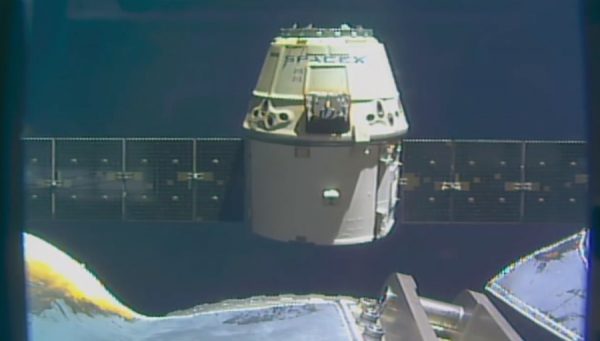Dragon cargo capsule brings home space station science experiments – Spaceflight Now

SpaceX’s 19th Dragon resupply mission to the International Space Station ended Tuesday with the capsule’s splashdown in the Pacific Ocean southwest of Los Angeles with nearly 3,600 pounds of cargo and experiments.
The reusable Dragon supply ship concluded a 30-day stay at the space station at 5:05 a.m. EST (1005 GMT) Tuesday, when the station’s Canadian-built robotic arm released the Dragon spacecraft.
The release of the Dragon capsule came after the spaceship was detached from the station’s Harmony module and maneuvered to a position below the complex using the robotic arm.
SpaceX flight controllers in Hawthorne, California, monitored the Dragon spacecraft’s departure from the space station, while station commander Luca Parmitano tracked the capsule’s movements until it exited the vicinity of the research lab.
The Dragon spacecraft closed its navigation bay door later Tuesday and ignited its Draco engines for a nearly 13-minute deorbit burn at 9:51 a.m. EST (1451 GMT). The braking maneuver put the spacecraft on a trajectory to re-enter the atmosphere on a northwest to southeast flight path over the Pacific Ocean.
The SpaceX supply ship jettisoned a disposable trunk section to burn up in the atmosphere, while a heat shield protected the Dragon’s pressurized compartment during a scorching hot plunge back to Earth.
Parachutes deployed to slow the ship’s velocity for splashdown at 10:42 a.m. EST (1542 GMT) Tuesday in a recovery zone around 202 miles (325 kilometers) southwest of Long Beach, California.
SpaceX teams were standing by to hoist the capsule from the sea and take it to the Port of Los Angeles, where cargo and research specimens will be handed over to NASA and others for distribution to scientists around the world.
The Dragon’s return to Earth on Tuesday marked the conclusion of this specific capsule’s third flight to the space station, and SpaceX’s 19th resupply mission to the station since 2012 under a multibillion-dollar cargo transportation contract with NASA.
SpaceX has one more resupply mission using its first-generation Dragon spacecraft design before transitioning to the company’s upgraded Dragon 2 vehicle, which will have two variants tailored for crew and cargo flights to the space station.
At least six dedicated space station cargo missions using Dragon 2 spacecraft are planned beginning in August and running through 2024. Crewed flights of the Dragon 2 will also carry limited cargo to and from the station.
The Dragon spacecraft that returned to Earth Tuesday arrived at the orbiting complex Dec. 8, two days after launch from Cape Canaveral aboard a Falcon 9 rocket.
The Dragon spacecraft delivered 5,769 pounds (2,617 kilograms) of supplies, experiments and hardware for the space station and its six-person crew.
The cargo carried to the station included 40 genetically-enhanced mice, part of a scientific experiment to gauge the effectiveness of an experimental drug to combat muscle and bone atrophy.
The 40 mice were expected to Earth inside the Dragon spacecraft Tuesday.
Other payloads delivered to the station last month included a beer brewing experiment and a CubeSat developed by Mexican university students.
There was also an experiment to help scientists investigate flame behavior in confined spaces in microgravity, plus a Japanese Earth-imaging camera and a new lithium-ion battery for the space station’s solar power truss.
NASA says the Dragon spacecraft came back to Earth with approximately 3,600 pounds (1,630 kilograms) of scientific research specimens and equipment. Besides the mice and a host of biological samples, the capsule returned a failed battery charge/discharge unit retrieved by astronauts on an earlier spacewalk for analysis by engineers on the ground.
The Dragon spacecraft is one of several resupply vehicles that fly to the space station, operating alongside the Northrop Grumman Cygnus cargo freighter, Russia’s Progress logistics vehicle, and Japan’s HTV supply ship.
The Dragon spacecraft is the only member of the space station’s fleet of visiting vehicles capable of returning significant cargo to Earth.
Email the author.
Follow Stephen Clark on Twitter: @StephenClark1.






